Squirmy Wormy Fly: How to Tie And 4 Great Patterns
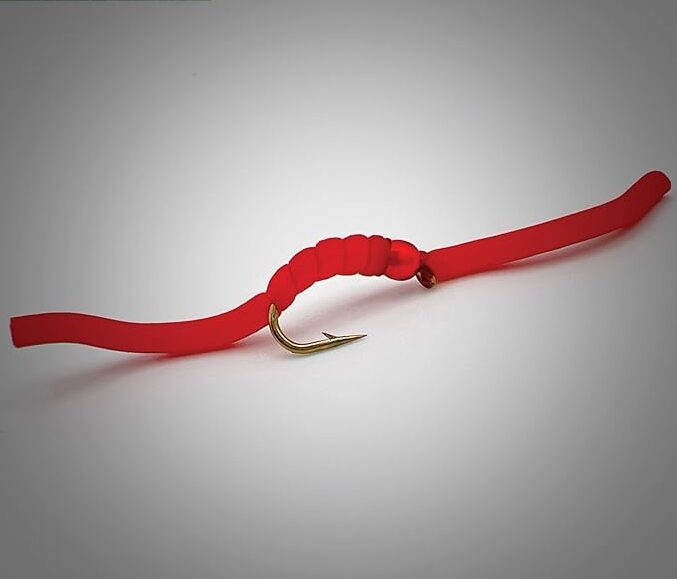
The squirmy wormy is my secret weapon in my fly box, especially when fishing for trout and grayling gets tough.
I often turn to these flies when the weather and water conditions are not ideal, and I’ve lost count of how many times they’ve saved what seemed like a slow day on the water.
Whether you love them or hate them, squirmy wormy flies have a knack for catching trout and grayling when traditional patterns just aren’t doing the trick.
This is especially true during the cold winter and spring months when hungry fish are looking for a hearty meal.
Sometimes, tying on a squirmy wormy fly feels like cheating, but any guilt quickly disappears when I start reeling in fish after fish.
In this guide, I will tell you all about squirmy wormy flies and how to tie them.
Must Read: An In-depth Guide on Fly Fishing Tippet
Fishing with Squirmy Wormy flies
Fishing with Squirmy Wormy flies is pretty straightforward. You can tie it on like any nymph, put it under an indicator, or fish it through prime holding spots with a tight line. There’s no wrong way to use this fly.
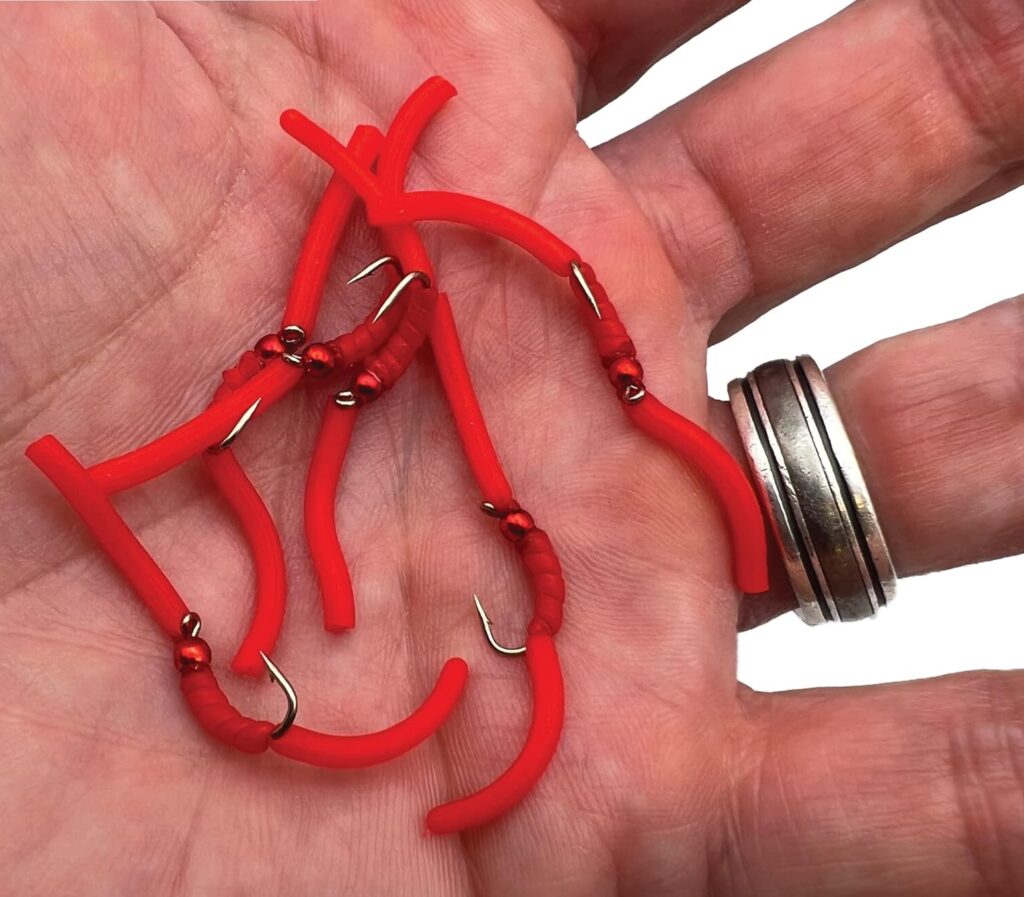
However, it’s worth mentioning that I usually don’t use a Squirmy Wormy as the top fly in a tandem rig. The floppy ends of the fly move a lot in the water, which is great for attracting strikes, but it can also cause twisting.
If you attach another fly to the bend of the hook on a Squirmy Wormy, the tail of the fly might tangle with the dropper’s line. Sometimes, the whole rig can twist up, and if you get a strike on the dropper, the twisted line can break.
That’s why I prefer using the Squirmy Wormy as the dropper on a tandem rig.
The most important thing to consider when fishing with Squirmy Wormy flies is color. Different colors work better at different times.
When the water is high or a bit murky, bright colors like fluorescent green, hot pink, fluorescent orange, and fluorescent yellow can be really effective.
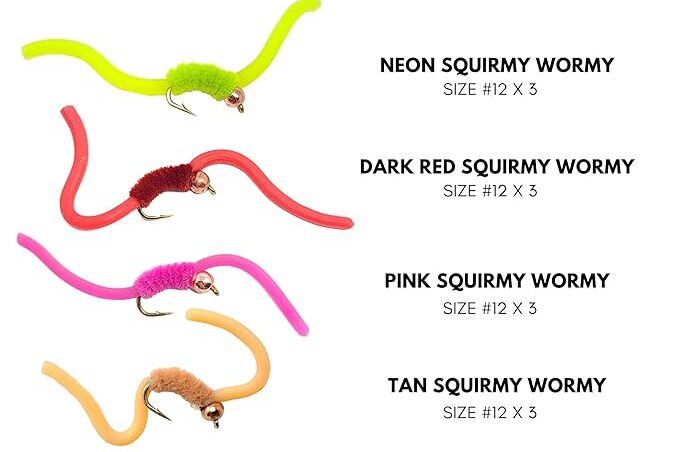
If I had to pick just two colors from that list, I’d go with fluorescent green and hot pink, with fluorescent green being my top choice.
On the other hand, when the water is low and clear, go for more natural colors like brown, red, purple, and even white.
These colors work best for me later in the season, especially on streams that get a lot of fishing pressure. In those situations, trout tend to avoid the bright-colored flies.
Benefits of Using the Squirmy Wormy Fly
The Squirmy Wormy Fly is a favorite among fly fishermen for several reasons. First, its lifelike appearance and realistic movement are irresistible to fish.
The way it squirms in the water imitates a live worm, triggering fish to strike. Plus, it’s super versatile, working well in different fishing conditions and for various fish species.
Another great thing about the Squirmy Wormy Fly is how easy it is to tie. You don’t need fancy skills or lots of materials.
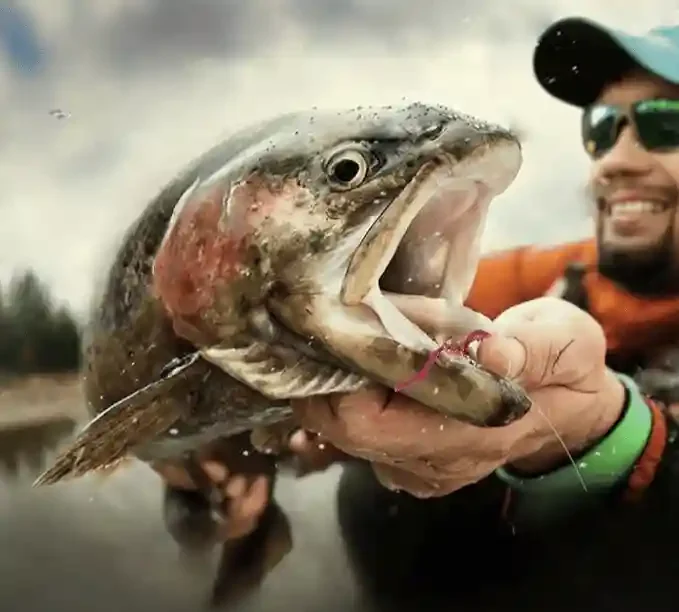
With just a few basic items and simple techniques, you can make your own effective flies. This makes it perfect for beginners or anyone wanting to learn more about tying flies.
What’s more, the Squirmy Wormy Fly is tough. Unlike real worms that can get damaged easily, the synthetic material used in these flies holds up even after multiple strikes and catches.
They last longer, saving you time and money in the end.
Recommended: How To Fish Emerger For Trout
Materials and Tools Needed for Tying the Squirmy Wormy Fly
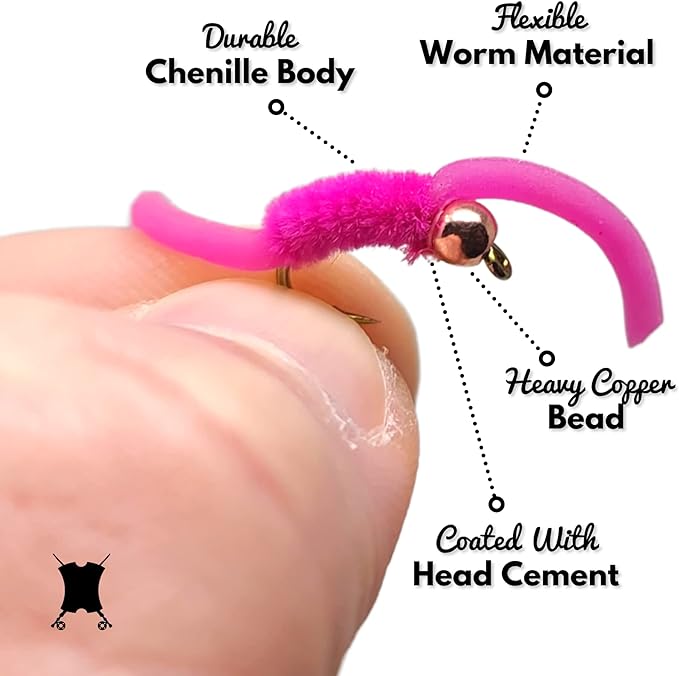
Before you can start tying your own Squirmy Wormy Flies, you’ll need to gather the necessary materials and tools. Here’s a list of what you’ll need:
Material
- Squirmy Wormy material (available in various colors)
- Hook (sizes 10-16)
- Thread (color to match the Wormy material)
- Bead 3 to 4mm slotted metallic pink tungsten
- Body & tail: Hot pink Veniard worm body
Tools
- Vise
- Bobbin
- Scissors
- Whip finisher
- Bodkin or needle
Now that you have everything you need, let’s move on to the step-by-step guide on tying the Squirmy Wormy Fly.
Must Read: History of Fly Fishing
Step-by-Step Guide on Tying the Squirmy Wormy Fly

Step 1: Start by securing the hook in your vise and attaching the thread
Step 2: Wrap the thread along the shank of the hook, creating a smooth base layer.
Step 3: Take a small piece of Squirmy Wormy material and fold it in half.
Step 4: Position the folded end of the material on top of the hook shank, approximately one-third of the way down from the eye.
Step 5: Secure the material to the hook by making tight wraps with the thread.
Step 6: Trim the excess material, leaving a small tag end to create a smoother transition.
Step 7: Continue wrapping the thread towards the rear of the hook, covering the tag end, and securing the material in place.
Step 8: Once you reach the rear of the hook, wrap the thread forward again, creating a smooth underbody.
Step :9 Repeat steps 3-8 to add additional sections of Squirmy Wormy material, building up the body of the fly.
Step 10: Once you’ve reached the desired body length, tie off the thread and trim the excess.
Step 11: Optionally, you can add a bead to the front of the fly for added weight and attraction.
Step 12: Use a whip finisher to secure the thread and create a neat knot.
Step 13: Trim any remaining thread, and your Squirmy Wormy Fly is ready to fish!
If You want you can Watch a video.
3 Great Patterns for Squirmy Wormy
Using silicone rubber and tungsten beads in different colors allows for the creation of many variations of the Squirmy Wormy fly. Here are some variations I use for trout and grayling fishing:
1. Earthworm Squirmy Wormy
Materials
- Hook: #12 or #14 HENDS BL 120
- Bead: 3.5 mm metallic orange tungsten
- Underbody: 8 turns of lead wire
- Thread: Orange GLOBRITE floss
- Body & tail: Earthworm Veniard worm body
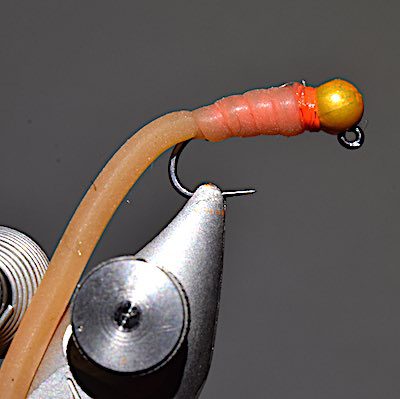
This fly, with its earthworm-colored body, works well in clear water.
2. Blood-red Squirmy Wormy
Materials
- Hook: #12 or #14 HENDS BL 120
- Bead: 3.5 mm pink tungsten
- Underbody: 8 turns of lead wire
- Thread: Pink GLOBRITE floss
- Body & tail: Blood-red Veniard worm body
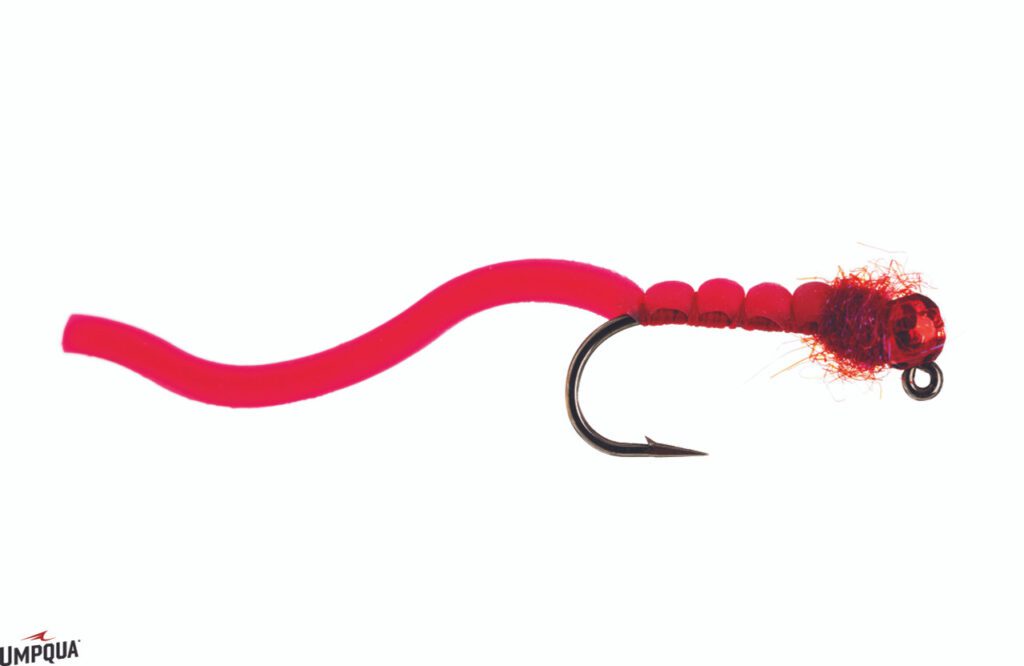
This fly, which can be tied with one or two tails, is effective in various conditions.
3. Squirmy Wormy Aqua Glow in the Dark
Materials
- Hook: #12 or #14 HENDS BL 120
- Bead: 3.5 mm pink tungsten
- Underbody: 8 turns of lead wire
- Thread: Pink GLOBRITE floss
- Body & tail: Blood-red Veniard worm body
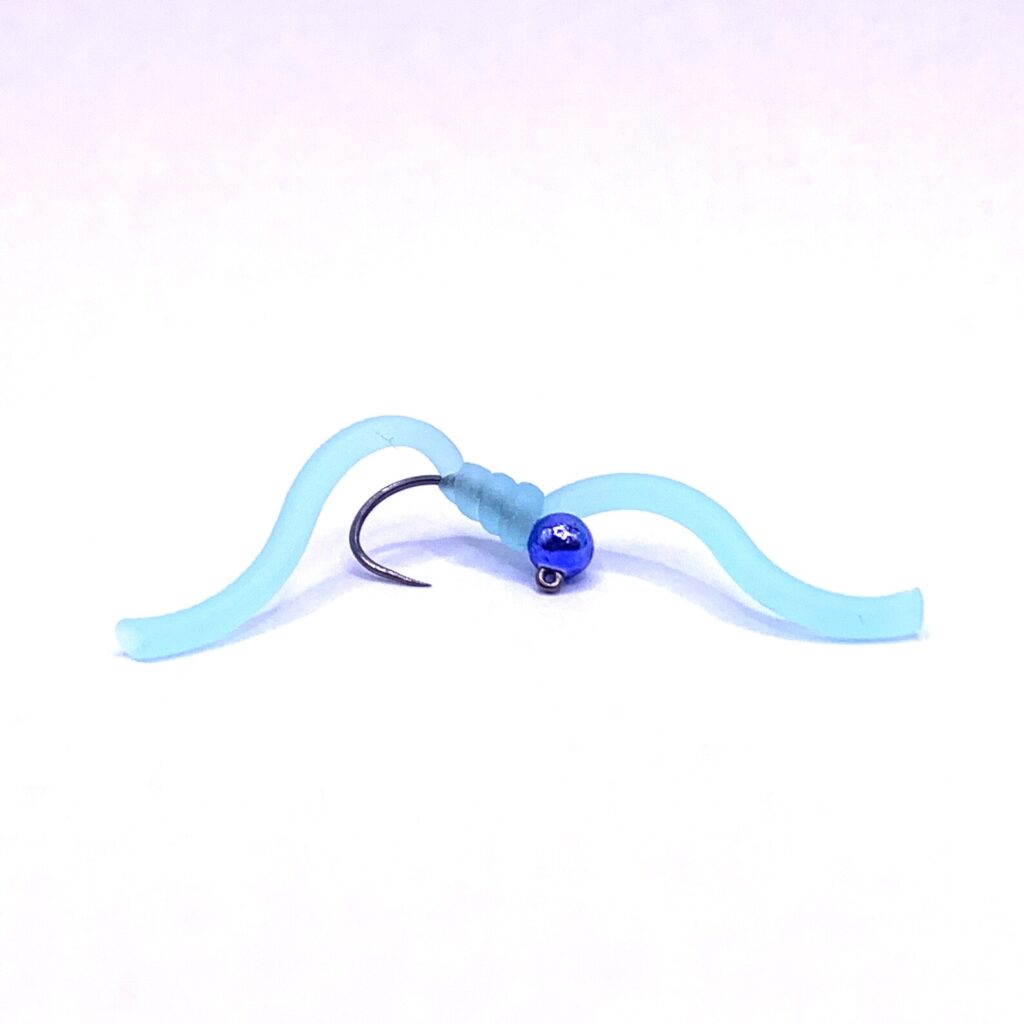
This pattern, with its unique glow-in-the-dark body, is great for Stillwaters.
When and How to Fish Squirmy Wormy
Originally developed for fishing rivers in the US, Squirmy Wormy flies have become highly effective for catching fish on UK rivers and stillwaters. They are often used when other flies fail or in poor fishing conditions.
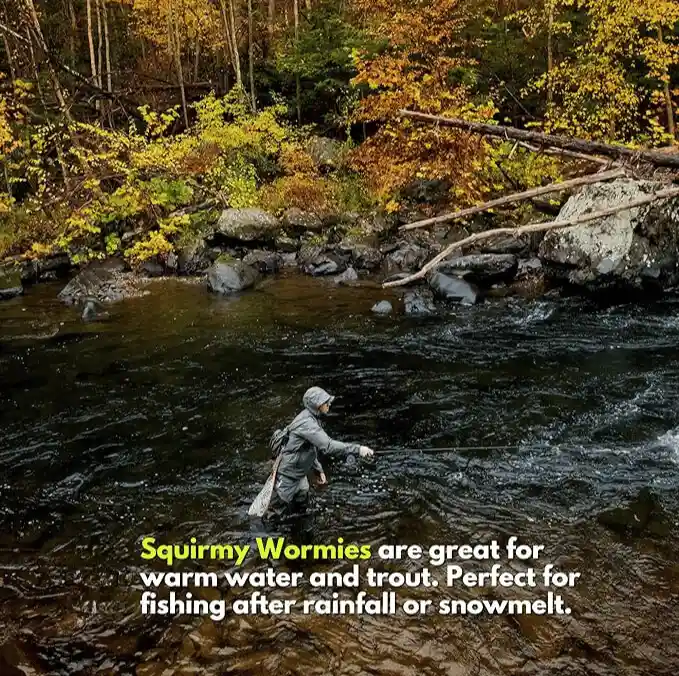
When fishing on rivers, I prefer using Squirmy patterns on the middle dropper, along with a heavier nymph on the point and a lighter nymph on the top dropper.
Short-range nymphing is the best approach to fishing these flies through likely runs and pools.
On stillwaters, Squirmy Wormy flies can be fished like a lure on an intermediate or sinking line, with short erratic pulls to animate the legs.
Alternatively, they can be fished under a bung by casting it out and either allowing it to drift or retrieving it with small twitches.
Experimenting with different techniques and color variations can help maximize your success with Squirmy Wormy flies.
So, grab your materials and get ready to tie and fish these versatile patterns on your local river or stillwater!
Tips for Fishing the Squirmy Wormy Fly Effectively
Here are some tips to help you make the most of your Squirmy Wormy Flies when you’re out fishing:
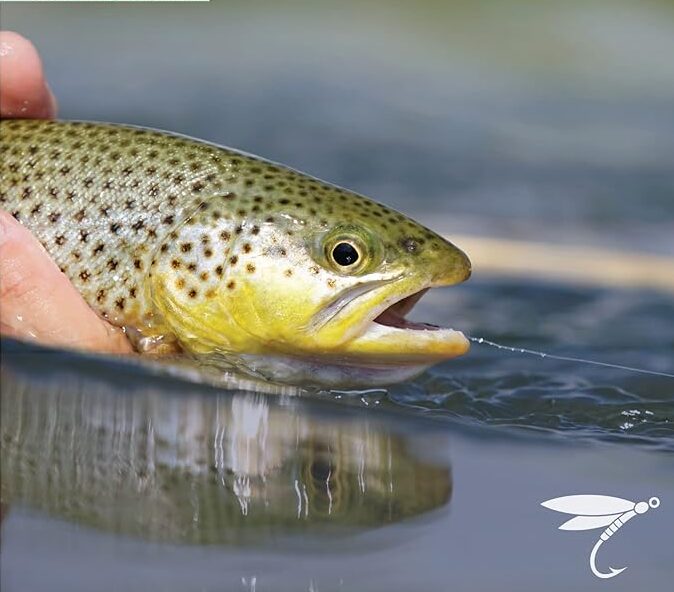
- Focus on presentation: Cast your fly where you think the fish are feeding, like near banks, weeds, or structures. Let your fly drift naturally with the current to mimic a real worm’s movement.
- Try different retrieves: Experiment with different ways of pulling your fly in. You can slowly strip it, twitch it, or just let it drift. See how the fish react and adjust your technique accordingly.
- Match the local insects: Even though the Squirmy Wormy Fly is great for attracting fish, it’s good to think about what bugs are around. Look at what insects are in the water and choose colors that look like the worms or larvae fish are eating.
- Use the right size: Change up the size of your flies depending on what fish you’re going for and the conditions. Smaller ones are good for trout that are picky, while bigger ones might catch the eye of bass or pike.
- Be sneaky: Approach the water quietly and try not to scare the fish. Stay low and use thin lines so your fly looks as natural as possible.
Final Words
The Squirmy Wormy Fly is a game-changer in fly fishing. Its lifelike appearance and irresistible movement make it a favorite among anglers, and tying your own adds a personal touch to your fishing trips.
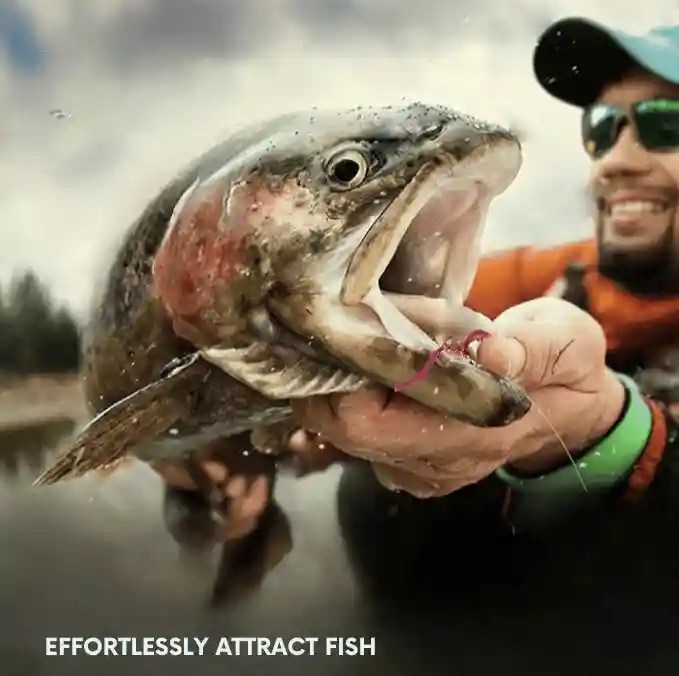
With our easy guide, you can tie effective Squirmy Wormy Flies and boost your chances of catching big fish.
Don’t be afraid to try different techniques, retrieve styles, and colors to see what works best where you fish. And don’t stop there – consider adding other awesome patterns like the San Juan Worm, Woolly Bugger, and Adams Parachute to your fly box.
This way, you’ll be ready for any fishing conditions.
So, grab your vise, gather your materials, and get ready to tie and fish with these fantastic fly patterns.
With the Squirmy Wormy Fly and other effective patterns in your collection, you’ll be all set for some great fly fishing adventures. Happy fishing!

Meet Ibrahim Khan, an avid angler and author in Fishing Teach. He shares his wealth of knowledge from his 16 years of experiences in fishing. His articles are a captivating blend of practical insights and thrilling tales that invite readers into the enchanting world of fishing.
Ibrahim’s guides are your go-to guide in the realm of fishing on this informational site. Hailing from a coastal paradise, Ibrahim’s passion for angling is the heartbeat of his life.
